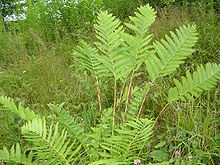Royal ferns
This article was based on formal or substantive deficiencies in the quality assurance biology in the section "plants" entered for improvement. This is done in order to bring the quality of the biology articles to an acceptable level. Please help improve this article! Articles that are not significantly improved can be deleted if necessary.
Read the more detailed information in the minimum requirements for biology articles .
| Royal ferns | ||||||||||||
|---|---|---|---|---|---|---|---|---|---|---|---|---|

Royal fern ( Osmunda regalis ), illustration |
||||||||||||
| Systematics | ||||||||||||
|
||||||||||||
| Scientific name | ||||||||||||
| Osmunda | ||||||||||||
| L. |
Royal ferns ( Osmunda ), also called panicle ferns , are a genus in the family of the royal fern family (Osmundaceae), which belongs to the ferns . There are 15 species of terrestrial ferns.
description
The sporangia are not combined to form sori and they lack an annulus .
distribution
The home of the species is mainly the northern hemisphere and the subtropics ; rarely in the Neotropic .
The fossil find of Osmunda claytoniites from the Antarctic Triassic is interesting . Osmunda claytoniana and its approximately 200 million year old relative Osmunda claytoniites can hardly be distinguished morphologically. The genus Osmunda is at least 200 million years old and thus one of the longest detectable plant genera on earth.
Systematics
The genus King Ferns ( Osmunda ) includes around 15 species. Only the king fern ( Osmunda regalis ) occurs in the Central European flora . The species has its main distribution center in Atlantic Europe; in addition, it is distributed almost worldwide in the temperate zones.
The related species are also interesting:
- Osmunda bromeliifolia (C. Presl) Copel. : It occurs in Sabah and the Philippines.
- In the devil fern, also called dark crown fern or coin roll fern ( Osmunda claytoniana L. ), the feathers of the fertile leaves in the middle area are skeletonized and have spore capsules - purely sterile leaves without sporangia also occur. The range of the species is North America and East Asia.
- Osmunda japonica Thunb. : It occurs in China, Japan, Korea, Taiwan and Sakhalin.
The cinnamon fern , also called the cinnamon-brown royal fern , is no longer included in the genus ( Osmundastrum cinnamomeum (L.) C. Presl , formerly Osmunda cinnamomea L. ). He has leaves that are used purely for assimilation and purely for spore formation . The species occurs in North, Central and South America as well as in East Asia. Young leaves are collected in Canada and the stalks are prepared like asparagus. The generic name was chosen as a reminder of the Nordic god of thunder, Thor , who is nicknamed Osmunder .
photos
King fern ( Osmunda regalis ), young fern fronds being rolled out
King fern ( Osmunda regalis ), just developing fertile part of the fern frond
Individual evidence
- ^ A b Osmunda in the Germplasm Resources Information Network (GRIN), USDA , ARS , National Genetic Resources Program. National Germplasm Resources Laboratory, Beltsville, Maryland. Retrieved February 20, 2019.



